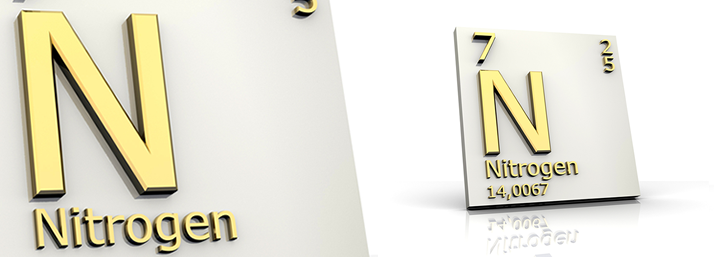Nitrogen Testing

Nitrogen Analysis & Techniques Used:
The method in use is an upgraded form of that originally researched in Switzerland and marketed by various firms in the US. Fundamentally, the scheme involves combustion of a sample in ultra-pure oxygen at 990 deg C in a closed system.
The products (gasses) are swept through copper to remove excess Oxygen and silver salts to remove halogens, phosphorus, and sulfur. Since the heat conductivity depends upon it’s composition, the mixture of remaining gasses is sensed. The H2O is removed. Later the CO2 is removed and finally only N2 remains. Sensing is done after each removal.
The instrument is calibrated using various standards from the NIST. Thus all three elements can be determined in one run from the same sample selection. Running one sample at a time enables us to check for inorganic residue post combustion.
Interferences are very few. Very high fluorine levels (>60%) can cause high nitrogen results. This can be circumvented. The optimal sample size depends upon theory. It is always best that the analyst knows all elements present (the molecular formula). If completely unknown, the operator will select about 2 mg for analysis.
This equipment does well in the analysis of air-sensitive samples. These samples are sealed under nitrogen (in a controlled atmosphere) in preweighed capsules. After removal from the glove box, the capsule is reweighed and quickly inserted into the analyzer. This “special handling” process can be done in less than 4 minutes thus minimizing any degradation of the sample. There is a correction made for the increased nitrogen blank from the glove box gas.
What is Nitrogen?
Atomic weight 14.00, Atomic Number 7, Melting Point -210 C, Boiling Point -195.79 C.
Nitrogen is a chemical element which has the symbol N and atomic number 7 in the periodic table. Elemental nitrogen is a colorless, odorless, tasteless and mostly inert diatomic gas at standard conditions, constituting 78.08% percent of Earth’s atmosphere.
Nitrogen is a constituent element of all living tissues and amino acids. Many industrially important compounds, such as ammonia, nitric acid, and cyanides, contain nitrogen.
Nitrogen is a non-metal, with an electronegativity of 3.0. It has five electrons in its outer shell and is therefore trivalent in most compounds. Nitrogen condenses at 77 K at atmospheric pressure and freezes at 63 K. Liquid nitrogen is a common cryogen.
Relevant sites about Nitrogen




